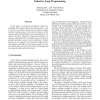611 search results - page 53 / 123 » Using GP to Model Contextual Human Behavior |
ICIP
2003
IEEE
14 years 9 months ago
2003
IEEE
Current computational models of visual attention focus on bottom-up information and ignore scene context. However, studies in visual cognition show that humans use context to faci...
ICTAI
2007
IEEE
14 years 2 months ago
2007
IEEE
In this paper we developed an Inductive Logic Programming (ILP) based framework ExOpaque that is able to extract a set of Horn clauses from an arbitrary opaque machine learning mo...
TOG
2002
13 years 7 months ago
2002
For an animated human face model to appear natural it should produce eye movements consistent with human ocular behavior. During face-to-face conversational interactions, eyes exh...
ATAL
2008
Springer
13 years 10 months ago
2008
Springer
Crowd simulation models are currently lacking a commonly accepted validation method. In this paper, we propose level of presence achieved by a human in a virtual environment (VE) ...
CHI
2008
ACM
14 years 8 months ago
2008
ACM
We designed an activity-based prototyping process realized in the ActivityDesigner system that combines the theoretical framework of Activity-Centered Design with traditional iter...


